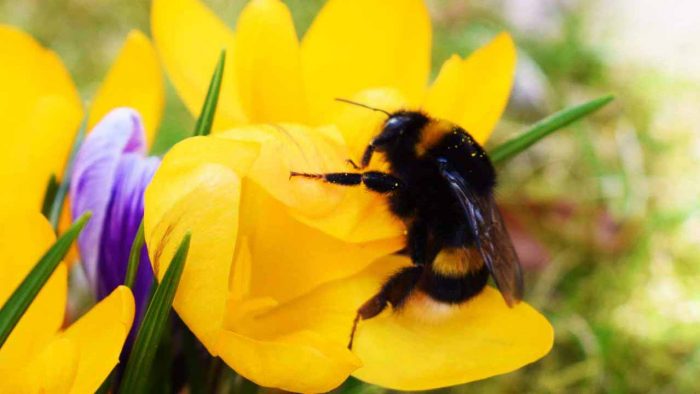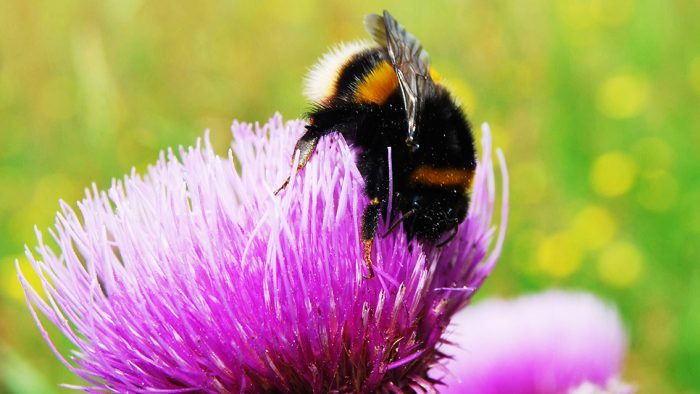Join the search for early bumblebees emerging now!
March 9, 2022
Join our bee expert Catherine in the search for early spring bumblebees and find out why climate change means we could find more winter-active bumblebees on our doorstep in future.

As we leave winter behind us, the evenings are getting lighter, and in the warmth of the sun spring bulbs are beginning to creep above ground. If you’re anything like me, you’ll now be peering keenly into every crocus flower, checking out blossom trees and listening out for that familiar buzz around every corner. Now is the perfect time to go in search of your first bumblebee of the year. The earliest emerging species can be seen as early as February, generally appearing earlier in the south of England than the north.
Surviving spring – the resilient bumblebee
The conditions in spring can be remarkably variable, with everything from warm sunshine, heavy rain and even hard frosts and snowfall. This presents a challenge for emerging insects, which may surface in a warm spell, only to be subjected to dropping temperatures days later. Bumblebees, however, are resilient insects, that are well adapted to the cooler climates in which they live.
Queens chose nesting sites that are sheltered and well insulated, therefore protecting their offspring from inclement weather. Bumblebees are covered in thick hair, which keeps them warm. They can also raise their body temperature, in order to generate the power needed for flight. To do so, they contract their flight muscles simultaneously, shivering to raise their internal temperature. The warmer they become, the faster they can shiver, generating yet more heat.
Despite this, bumblebees, like most other insects will avoid flying in the rain. Queens and workers may remain in the nest, while males can be found sheltering under the canopy of a flower. This makes long periods of wet weather challenging to survive.
Winter-active bumblebees
For one of our most common bumblebees, the Buff-tailed bumblebee (Bombus terrestris), winter can be just as busy a time as spring. In a phenomenon first observed in southern England in the 1990s, buff-tailed bumblebee workers have been recorded throughout winter, suggesting a proportion of queens were forgoing hibernation altogether and establishing nests in the late autumn. Now in the warmer parts of the UK, fully active winter colonies of this species are regularly recorded, even when temperatures are close to freezing and there is snow on the ground.
These bumblebees are probably exploiting the growing amount of nectar and pollen rich plants available to them throughout the winter. Plants like mahonia, winter-flowering heathers, honeysuckle and cyclamens can be commonly found in winter gardens, while gorse, which flowers in late winter, is a regular feature in parkland areas.

Will we see winter-active bumblebees in the Yorkshire Dales?
This winter activity has almost only been recorded in towns and cities so far, and most frequently in the south of England. Temperatures in the south are usually a few degrees higher than in the northern parts of the country, therefore the winters are somewhat less severe. Large cities also tend to be warmer than small towns and the countryside, due to a phenomenon known as the urban heat island effect. Cities are full of surfaces that absorb and hold heat, in comparison to less developed areas, resulting in a difference in temperature between the two. Finally, towns and cities have more gardens and parks, and therefore more winter flowering plants than their rural counterparts.
Although the Dales in winter might be a little too cold for even the hardiest of bees, evidence suggests this may not be true for long. As we experience increasing temperatures linked to climate change, perhaps we can expect to see winter-active bumblebees are on our doorstep.
Join our Bumblebee Challenge!
Join the search for spring bumblebees by taking part in our Bumblebee Challenge. We’d love to see your photos and hear about your sightings – and there are prizes up for grabs for the best ones! Find out more about our Bumblebee Challenge.






